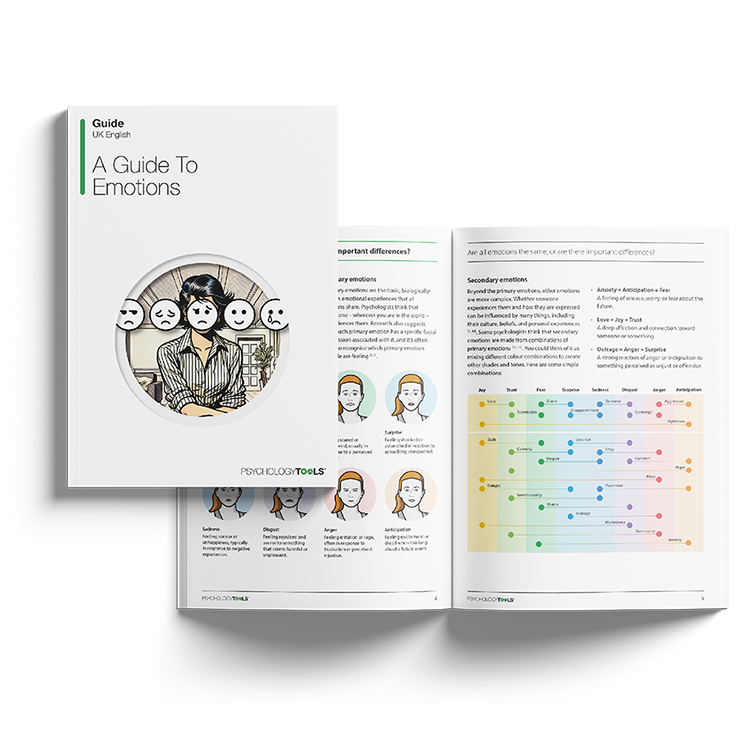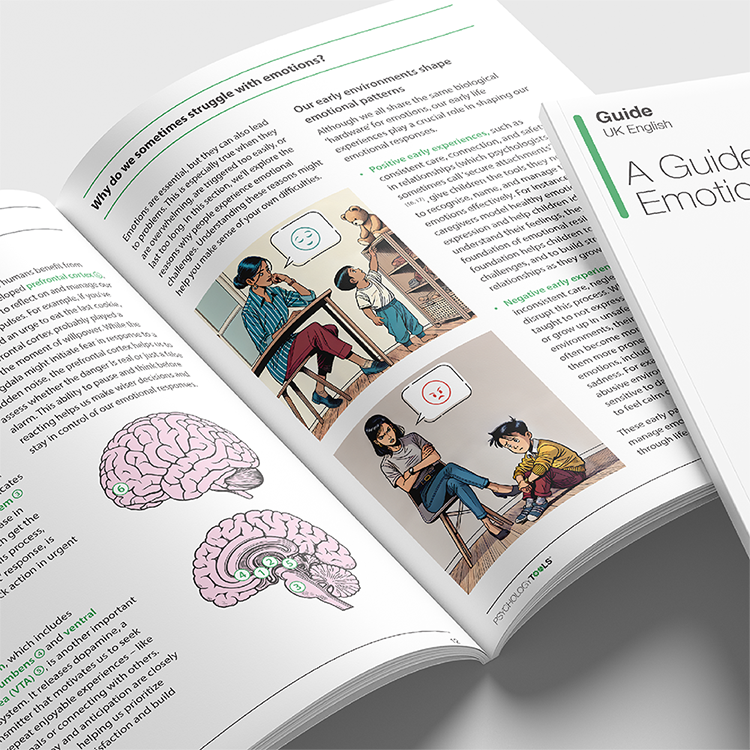Guide (PDF)
A psychoeducational guide. Typically containing elements of skills development.
A comprehensive guide exploring the origins, functions, and experience of emotions, including emotional difficulties.

A psychoeducational guide. Typically containing elements of skills development.
To use this feature you must be signed in to an active account on the Advanced or Complete plans.

Emotions are central to psychological wellbeing, affecting how we view ourselves, relate to others, and respond to events. In therapy, helping clients understand the nature, function, and impact of emotions is important for developing meaningful case conceptualisations and effective treatment plans. This guide introduces clients to key emotional concepts, including what emotions are, how they differ from one another, and the reasons people experience them. It also explores why emotional difficulties arise, how they contribute to mental health issues, and how different therapeutic models make sense of emotional disturbances.
Many clients struggle with emotions that feel distressing, confusing, or overwhelming. Helping clients understand their emotions - how they work, why they exist, and when they cause difficulties — lays the groundwork for effective intervention and emotional regulation.
This resource helps clients:
Helps clients identify and understand low mood.
Explains emotional arousal and avoidance in generalized anxiety, social anxiety, and panic.
Providing insight into emotional reactivity associated with traumatic experiences.
Explores how emotions sometimes drive disordered eating.
Builds awareness and understanding of extreme emotional reactions.
Help for clients who struggle to identify or describe their emotions.
Identify clients who would benefit from learning more about their emotions.
Use the psychoeducational material to help clients understand their emotions.
Use client vignettes to normalize common difficulties with emotions.
Discuss the different ways emotional difficulties can be addressed in therapy.
Emotions play a crucial role in psychological functioning and mental health, influencing how individuals interpret their experiences, relate to others, and navigate daily life. For this reason, helping clients understand the nature and function of emotions, as well as how they contribute to mental health difficulties, is often important for case formulation and intervention.
Emotions are typically viewed as transient, multidimensional 'episodes' or 'feeling states' that arise in response to internal or external stimuli (Damasio, 1994; Hoffman, 2016; Moors & Scherer, 2013). They encompass cognitive components (thoughts and images linked to an emotion), motivational urges (action tendencies such as fight, flight, or affiliation), physiological responses (changes in arousal), and expressive behaviours (facial expressions, vocal tone). Emotions are also distinct from moods which tend to be longer-lasting and more diffuse.
Emotions serve several adaptive functions. From an evolutionary standpoint, they have been preserved because they offer survival advantages. For instance, fear increases awareness and promotes avoidance of threats, while disgust helps protect against harmful substances. Emotions also play a crucial role in social communication, decision-making, and memory consolidation. Clinically, emotions also serve as indicators of unmet needs, internal conflicts, or problematic cognitive patterns (Beck, 1976; Elliott et al., 2004).
However, emotional systems can become dysregulated. For example, emotional responses may be excessive, prolonged, too frequent, or contextually inappropriate (Gross & Jazaieri, 2014). Such issues may stem from various interconnected factors, including genetic predispositions, traumatic experiences, or attempts to avoid or suppress feelings. Additionally, evolved emotional responses may be mismatched with modern environments, contributing to clinical disorders.
Although emotions feature in many mental health difficulties, the nature of emotional disturbance can vary. For example, anxiety disorders often involve experiencing intense anxiety and/or fear, whereas depression is characterized by reduced positive emotions and a lack of emotional responsiveness (Kring & Bachorowski, 1999). For both therapists and clients, developing a nuanced understanding of emotions can help identify problematic patterns, support treatment planning, and inform appropriate interventions.
This guide is designed to help clients understand emotions and how they relate to common mental health difficulties. Sections include:

Just enter your name and email address, and we'll send you A Guide to Emotions (English US) straight to your inbox. You'll also receive occasional product update emails wth evidence-based tools, clinical resources, and the latest psychological research.
Working...
This site uses strictly necessary cookies to function. We do not use cookies for analytics, marketing, or tracking purposes. By clicking “OK”, you agree to the use of these essential cookies. Read our Cookie Policy